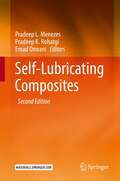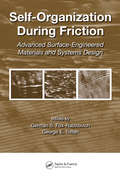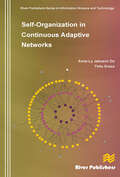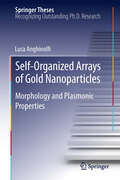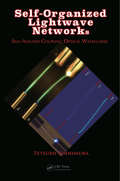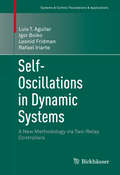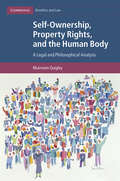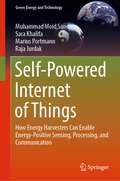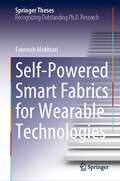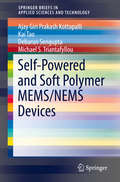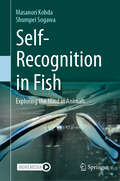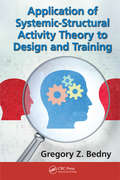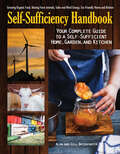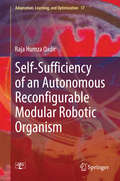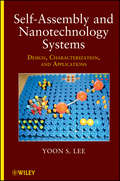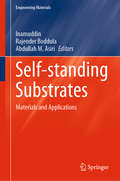- Table View
- List View
Self-Lubricating Composites
by Pradeep K. Rohatgi Pradeep L. Menezes Emad OmraniIn most tribological applications, liquid or grease based lubricants are used to facilitate the relative motion of solid bodies to minimize friction and wear between interacting surfaces. The challenges for liquid lubricants arise in extreme environmental conditions, such as very high or low temperatures, vacuum, radiation, and extreme contact pressure. At these conditions, solid lubricants may be the alternative choice which can help to decrease friction and wear without incorporating liquid lubricants. Challenges with solid lubricants are to maintain a continuous supply of solid lubricants on the contact surfaces to act as lubricous layer between two sliding surfaces. Such a continuous supply is more easily maintained in the case of liquid lubricants when compared to solid lubricants. The most innovative development to ensure a continuous supply of solid lubricant to the contact surface during sliding is to introduce solid lubricant as reinforcement into the matrix of one of the sliding components. Composite materials are engineered or naturally occurring materials which contain two or more distinct constituents with significantly different chemical, physical and mechanical properties. Composites consist of reinforcement and matrix (metal, polymer and ceramics). Among various reinforcements, recent emerging material, solid lubricant, is found to have many favorable attributes such as good lubrication property. Self‐lubrication is the ability of a material to provide lubrication to the contact surface to decrease friction and wear rate in the absence of an external lubricant by transferring embedded solid lubricants in the composite to the interface. Self-lubricating composites (SLCs) are an important category of engineering materials that are increasingly replacing a number of conventional materials in the automotive, aerospace, and marine industries due to superior tribological properties. In SLCs, solid lubricant materials, including carbonous materials, molybdenum disulfide (MoS2), and hexagonal boron nitride (h-BN) are embedded into the matrices as reinforcements to manufacture a novel material with attractive self-lubricating properties. Several studies have been investigated the tribological properties of self-lubricating materials. This book fills that gap to have a reference book about self-lubricating materials and their properties to help scientists, engineers, and industries. This book discusses mechanisms of self-lubricating materials, self-lubricating properties and the applications for industries. The chapters will be written by authoritative expertise in the field. Additionally, this book will demonstrate fundamental study and most advanced innovations in self-lubricating materials as regards to friction and wear. The chapters also include tribological properties of composites and coatings and some practical applications of self-lubricating materials.
Self-Organization During Friction: Advanced Surface-Engineered Materials and Systems Design
by George E. Totten German S. Fox-RabinovichIn our present era of nanoscience and nanotechnology, new materials are poised to take center stage in dramatically improving friction and wear behavior under extreme conditions. Compiled by two eminent experts, Self-Organization During Friction: Advanced Surface-Engineered Materials and Systems Design details the latest advances and developments i
Self-Organization in Continuous Adaptive Networks (River Publishers Series In Information Science And Technology Ser.)
by Thilo Gross Anne-Ly DoIn the last years, adaptive networks have been discovered simultaneously in different fields as a universal framework for the study of self-organization phenomena. Understanding the mechanisms behind these phenomena is hoped to bring forward not only empirical disciplines such as biology, sociology, ecology, and economy, but also engineering disciplines seeking to employ controlled emergence in future technologies. This volume presents new analytical approaches, which combine tools from dynamical systems theory and statistical physics with tools from graph theory to address the principles behind adaptive self-organization. It is the first class of approaches that is applicable to continuous networks. The volume discusses the mechanisms behind three emergent phenomena that are prominently discussed in the context of biological and social sciences:• synchronization,• spontaneous diversification, and• self-organized criticality.Self-organization in continuous adaptive networks contains extended research papers. It can serve as both, a review of recent results on adaptive self-organization as well as a tutorial of new analytical methodsSelf-organization in continuous adaptive networks is ideal for academic staff and master/research students in complexity and network sciences, in engineering, physics and maths.
Self-Organized Arrays of Gold Nanoparticles
by Luca AnghinolfiThis thesis addresses the fabrication and investigation of the optical response of gold nanoparticle arrays supported on insulating LiF(110) nanopatterned substrates. Motivated by the discovery of the intriguing effects that arise when electromagnetic radiation interacts with metallic nanostructures, the thesis focuses on the application of bottom-up approaches to the fabrication of extended-area plasmonic nanostructures, and the optimization of their optical response. By developing a sophisticated effective-medium model and comparing the experimental findings with model calculations, the author explores the role of the interparticle electromagnetic coupling and array dimensionality on the collective plasmonic behavior of the array, giving insights into the physical mechanisms governing the optical response.
Self-Organized Lightwave Networks: Self-Aligned Coupling Optical Waveguides
by Tetsuzo YoshimuraThis book gives a solution to the problem of constructing lightwave paths in free spaces by proposing the concept of a Self-Organized Lightwave Network (SOLNET). This concept enables us to form self-aligned coupling optical waveguides automatically. SOLNETs are fabricated by self-focusing of lightwaves in photosensitive media, in which the refractive index increases upon light beam exposure, to realize the following functions: 1) Optical solder: Self-aligned optical couplings between misaligned devices with different core sizes 2) Three-dimensional optical wiring 3) Targeting lightwaves onto specific objects SOLNETs are expected to reduce the efforts to implement lightwaves into electronic systems and allow us to create new architectures, thus reducing costs and energy dissipation and improving overall system performance. SOLNETs are also expected to be applied to a wide range of fields where lightwaves are utilized, for example, solar energy conversion systems and biomedical technologies, especially photo-assisted cancer therapies. Readers will systematically learn concepts and features of SOLNETs, SOLNET performance predicted by computer simulations, experimental demonstrations for the proof of concepts, and expected applications. They will also be prepared for future challenges of the applications. This book is intended to be read by scientists, engineers, and graduate students who study advanced optoelectronic systems such as optical interconnects within computers and optical networking systems, and those who produce new ideas or strategies on lightwave-related subjects.
Self-Organized Organic Semiconductors
by Quan LiThis book focuses on the exciting topic on self-organized organic semiconductors - from materials to device applications. It offers up-to-date and accessible coverage of self-organized semiconductors for organic chemistry, polymer science, liquid crystals, materials science, material engineering, electrical engineering, chemical engineering, optics, optic-electronics, nanotechnology and semiconductors. Chapters cover chemistry, physics, processing, and characterization. The applications include photovoltaics, light-emitting diodes (LEDs), and transistors.
Self-Organized Quantum Dots for Memories
by Tobias NowozinToday's semiconductor memory market is divided between two types of memory: DRAM and Flash. Each has its own advantages and disadvantages. While DRAM is fast but volatile, Flash is non-volatile but slow. A memory system based on self-organized quantum dots (QDs) as storage node could combine the advantages of modern DRAM and Flash, thus merging the latter's non-volatility with very fast write times. This thesis investigates the electronic properties of and carrier dynamics in self-organized quantum dots by means of time-resolved capacitance spectroscopy and time-resolved current measurements. The first aim is to study the localization energy of various QD systems in order to assess the potential of increasing the storage time in QDs to non-volatility. Surprisingly, it is found that the major impact of carrier capture cross-sections of QDs is to influence, and at times counterbalance, carrier storage in addition to the localization energy. The second aim is to study the coupling between a layer of self-organized QDs and a two-dimensional hole gas (2DHG), which is relevant for the read-out process in memory systems. The investigation yields the discovery of the many-particle ground states in the QD ensemble. In addition to its technological relevance, the thesis also offers new insights into the fascinating field of nanostructure physics.
Self-Organizing Networks (SON)
by Juan Ramiro Khalid HamiedWith the current explosion in network traffic, and mounting pressure on operators' business case, Self-Organizing Networks (SON) play a crucial role. They are conceived to minimize human intervention in engineering processes and at the same time improve system performance to maximize Return-on-Investment (ROI) and secure customer loyalty.Written by leading experts in the planning and optimization of Multi-Technology and Multi-Vendor wireless networks, this book describes the architecture of Multi-Technology SON for GSM, UMTS and LTE, along with the enabling technologies for SON planning, optimization and healing. This is presented mainly from a technology point of view, but also covers some critical business aspects, such as the ROI of the proposed SON functionalities and Use Cases.Key features:Follows a truly Multi-Technology approach: covering not only LTE, but also GSM and UMTS, including architectural considerations of deploying SON in today's GSM and UMTS networksFeatures detailed discussions about the relevant trade-offs in each Use CaseIncludes field results of today's GSM and UMTS SON implementations in live networksAddresses the calculation of ROI for Multi-Technology SON, contributing to a more complete and strategic view of the SON paradigmThis book will appeal to network planners, optimization engineers, technical/strategy managers with operators and R&D/system engineers at infrastructure and software vendors. It will also be a useful resource for postgraduate students and researchers in automated wireless network planning and optimization.
Self-Oscillations in Dynamic Systems
by Igor Boiko Leonid Fridman Luis T. Aguilar Rafael IriarteThis monograph presents a simple and efficient two-relay control algorithm for generation of self-excited oscillations of a desired amplitude and frequency in dynamic systems. Developed by the authors, the two-relay controller consists of two relays switched by the feedback received from a linear or nonlinear system, and represents a new approach to the self-generation of periodic motions in underactuated mechanical systems. The first part of the book explains the design procedures for two-relay control using three different methodologies - the describing-function method, Poincaré maps, and the locus-of-a perturbed-relay-system method - and concludes with stability analysis of designed periodic oscillations. Two methods to ensure the robustness of two-relay control algorithms are explored in the second part, one based on the combination of the high-order sliding mode controller and backstepping, and the other on higher-order sliding-modes-based reconstruction of uncertainties and their compensation where Lyapunov-based stability analysis of tracking error is used. Finally, the third part illustrates applications of self-oscillation generation by a two-relay control with a Furuta pendulum, wheel pendulum, 3-DOF underactuated robot, 3-DOF laboratory helicopter, and fixed-phase electronic circuits. Self-Oscillations in Dynamic Systems will appeal to engineers, researchers, and graduate students working on the tracking and self-generation of periodic motion of electromechanical systems, including non-minimum-phase systems. It will also be of interest to mathematicians working on analysis of periodic solutions.
Self-Ownership, Property Rights, and the Human Body: A Legal And Philosophical Analysis (Cambridge Bioethics And Law #43)
by Muireann QuigleyHow ought the law to deal with novel challenges regarding the use and control of human biomaterials?<P><P> As it stands the law is ill-equipped to deal with these. Quigley argues that advancing biotechnology means that the law must confront and move boundaries which it has constructed; in particular, those which delineate property from non-property in relation to biomaterials. <P>Drawing together often disparate strands of property discourse, she offers a philosophical and legal re-analysis of the law in relation to property in the body and biomaterials. She advances a new defence, underpinned by self-ownership, of the position that persons ought to be seen as the prima facie holders of property rights in their separated biomaterials. <P>This book will appeal to those interested in medical and property law, philosophy, bioethics, and health policy amongst others.<P> Includes a robust discussion of self-ownership and provides a new perspective to the legal literature.<P> Brings together legal and philosophical scholarship in the area and enriches the discourse by taking a wider and more integrated view.<P> Discusses in-depth the legislative and common law background by covering a number of jurisdictions: England and Wales, Scotland, US, Canada and Australia.
Self-Powered Internet of Things: How Energy Harvesters Can Enable Energy-Positive Sensing, Processing, and Communication (Green Energy and Technology)
by Raja Jurdak Marius Portmann Muhammad Moid Sandhu Sara KhalifaThis book covers cutting edge advancements on self-powered Internet of Things, where sensing devices can be energy-positive while capturing context from the physical world. It provides new mechanisms for activity recognition without the need of conventional inertial sensors, which demand significant energy during their operation and thus quickly deplete the batteries of internet-of-things (IoT) devices. The book offers new solutions by employing energy harvesters as activity sensors as well as power sources to enable the autonomous and self-powered operation of IoT devices without the need of human intervention. It provides useful content for graduate students as well as researchers to understand the nascent technologies of human activity, fitness and health monitoring using autonomous sensors. In particular, this book is very useful for people working on pervasive computing, activity recognition, wearable IoT, fitness/healthcare and autonomous systems.This book covers a broad range of topics related to self-powered activity recognition. The main topics of this book include wearables, IoT, energy harvesting, energy harvesters as sensors, activity recognition and self-powered operation of IoT devices. This book starts with the introduction of wearable IoT devices and activity recognition and then highlights the conventional activity recognition mechanisms. After that, it describes the use of energy harvesters to power the IoT devices. Later, it explores the use of various energy harvesters as activity sensors. It also proposes the use of energy harvesters as simultaneous source of energy and context information and defines the emerging concept of energy-positive sensing compared to conventional energy-negative sensing. Finally, it explores sensor/signal fusion to enhance the performance using multiple energy harvesters and charts a way forward for future research in this area. This book covers all important and emerging topics that have significance in the design and implementation of autonomous wearable IoT devices. We believe that this book will lay the foundation for designing self-powered IoT devices which can ultimately replace the conventional wearable IoT devices which need regular recharging and replacement.
Self-Powered Smart Fabrics for Wearable Technologies (Springer Theses)
by Fatemeh MokhtariThis book presents an innovative methodology to fabricate nanostructured piezoelectric composite fibers with wearable technologies application as an energy generator and/or sensors. It reports on methods of piezoelectric fiber formation and development of novel textile structures (weave, knit, braid, coil) with embedded electrodes. The flexibility and small diameter of the final fiber make it possible to use them in garment without affecting structure of comfort. The performance of the fiber generators was evaluated through different applications such as air and water sensor, health and movement monitoring, and energy generator. The book targets a wide readership including materials scientists, electrical engineering, soft robotics, Internet of things, electronic textiles, and wearable technology.
Self-Powered and Soft Polymer MEMS/NEMS Devices (SpringerBriefs in Applied Sciences and Technology)
by Michael S. Triantafyllou Ajay Giri Kottapalli Kai Tao Debarun SenguptaThis book explores the fabrication of soft material and biomimetic MEMS sensors, presents a review of MEMS/NEMS energy harvesters and self-powered sensors, and focuses on the recent efforts in developing flexible and wearable piezoelectric nanogenerators. It also includes a critical analysis of various energy harvesting principles, such as electromagnetic, piezoelectric, electrostatic, triboelectric, and magnetostrictive. This multidisciplinary book is appropriate for students and professionals in the fields of material science, mechanical engineering, electrical engineering, and bioengineering.
Self-Recognition in Fish: Exploring the Mind in Animals
by Masanori Kohda Shumpei SogawaThis book describes the process of making the major breakthrough in the study of animal self-awareness using fish. The discovery led by the author&’s team, proving the mirror self-recognition ability of fish, is vividly documented as they share the process of making, testing and verifying hypotheses and developing further hypotheses. The clear experimental results demonstrate the remarkable self-awareness in animals, overturning the conventional view and providing a key to understanding the origin of human self-awareness. Starting from the current understanding of fish brains, individual recognition by its face, the following chapters introduce the series of the authors&’ research projects designed to understand mirror self-recognition (MSR) in animals. The sequence of the research into fish&’s MSR is documented, including how it started, the failures and successes, and the struggles. Additional tests carried out in response to various criticisms of the work have led to a re-examination of the research methods used prior to the author&’s work. The book then addresses the question of exactly when and how some fish recognize themselves in a mirror, exploring the self-awareness and the &“mind&”, in other word &“Eureka moment&” in fish. This book points out and overturns the contradictions in conventional wisdom based on anthropocentrism and hypotheses about the evolution of self-awareness, proposing a new hypothesis that the self-awareness of humans and fish will be homologous. The book takes readers on an engaging exploration of the scientific experiments and the remarkable discovery of animal intelligence.
Self-Regulation in Activity Theory: Applied Work Design for Human-Computer and Human-Machine Systems (Ergonomics Design & Mgmt. Theory & Applications)
by Waldemar Karwowski Gregory Z. Bedny Inna BednyEvery complex human-machine system includes a computer as a critically important means of work. However, an operator's interaction with a computerized system cannot be reduced to only performing computer-based tasks. Today human-computer interaction (HCI) is not limited to trained software users. People of all ages use all different kinds of gadget
Self-Sufficiency Handbook: Your Complete Guide to a Self-Sufficient Home, Garden, and Kitchen
by Gill Bridgewater Alan BridgewaterWhether you&’re looking to adopt a greener lifestyle or wanting to go off the grid, this guide has all you need to know to boost your self-sufficiency. Worried about ever-rising fuel bills and longing for the day when you can be off-grid and independent? Anxious about the quality of the food you eat and planning to go organic? Yearning to get back to the way it was but don&’t know where to start? This book will show you how to achieve the eco-friendly good life. The authors cover the ecological gamut from geothermal heating to crop rotation to soap making. They answer important questions like how much land is really needed to be self-sufficient, whether or not to depend entirely on natural forms of energy, and which farm animals will best meet your needs. There&’s practical information here on building an insulated flue pipe chimney, identifying edible wild plants, and composting with worms—as well as recipes for jams, rhubarb wine, cheeses, and more. Packed with full-color photographs, helpful illustrations, and diagrams, Self-Sufficiency Handbook will appeal to urban dwellers who want to adopt certain aspects of greener living and to serious adherents of back-to-basics living.Inside Self-Sufficiency Handbook, you&’ll find: –Inspirational yet practical introduction to a greener way of living –Essential reading for anyone considering a shift to a more self-sufficient lifestyle, no matter how small the change –Emphasis is on the positive aspects of self-sufficiency, such as cutting living costs and eating well –Covers everything from fitting a wind turbine to making honey from your own beehives. –Step-by-step instructions on keeping animals, growing organic food, and preserving your own produce –Guidelines for creating a self-sufficient home and eco-friendly home improvements&“This book shows that self-sufficiency is not only better for the planet—it&’s cheaper and more rewarding!&” —Green Rewards/Sustainability Advisory Panel
Self-Sufficiency of an Autonomous Reconfigurable Modular Robotic Organism
by Raja Humza QadirThis book describes how the principle of self-sufficiency can be applied to a reconfigurable modular robotic organism. It shows the design considerations for a novel REPLICATOR robotic platform, both hardware and software, featuring the behavioral characteristics of social insect colonies. Following a comprehensive overview of some of the bio-inspired techniques already available, and of the state-of-the-art in re-configurable modular robotic systems, the book presents a novel power management system with fault-tolerant energy sharing, as well as its implementation in the REPLICATOR robotic modules. In addition, the book discusses, for the first time, the concept of "artificial energy homeostasis" in the context of a modular robotic organism, and shows its verification on a custom-designed simulation framework in different dynamic power distribution and fault tolerance scenarios. This book offers an ideal reference guide for both hardware engineers and software developers involved in the design and implementation of autonomous robotic systems.
Self-Sufficient Agriculture: Labour and Knowledge in Small-Scale Farming
by Robert TrippLow external-input technology (or LEIT) is an increasingly prominent subject in discussions of sustainable agriculture. There are growing calls for self-sufficient agriculture in an era experiencing diminishing returns from reliance upon expensive synthetic pesticides and fertilizers. There are many reasons to support strategies for low external input farming, including a concern for environmental sustainability, increased attention to resource-poor farmers and marginal environments, and the conviction that a better use of local resources in small-scale agriculture can improve farm productivity and innovation. But despite the increased attention to self-sufficient agriculture, there is little evidence available on the performance and impact of LEIT. This book examines the contributions and limitations of low external input technology for addressing the needs of resource-poor farmers. For the first time a balanced analysis of LEIT is provided, offering in-depth case studies, an analysis of the debates, an extensive review of the literature and practical suggestions about the management and integration of low external input agriculture in rural development programmes.
Self-Tracking: The Mit Press Essential Knowledge Series (The MIT Press Essential Knowledge series)
by Gina Neff Dawn NafusWhat happens when people turn their everyday experience into data: an introduction to the essential ideas and key challenges of self-tracking.People keep track. In the eighteenth century, Benjamin Franklin kept charts of time spent and virtues lived up to. Today, people use technology to self-track: hours slept, steps taken, calories consumed, medications administered. Ninety million wearable sensors were shipped in 2014 to help us gather data about our lives. This book examines how people record, analyze, and reflect on this data, looking at the tools they use and the communities they become part of. Gina Neff and Dawn Nafus describe what happens when people turn their everyday experience—in particular, health and wellness-related experience—into data, and offer an introduction to the essential ideas and key challenges of using these technologies. They consider self-tracking as a social and cultural phenomenon, describing not only the use of data as a kind of mirror of the self but also how this enables people to connect to, and learn from, others.Neff and Nafus consider what's at stake: who wants our data and why; the practices of serious self-tracking enthusiasts; the design of commercial self-tracking technology; and how self-tracking can fill gaps in the healthcare system. Today, no one can lead an entirely untracked life. Neff and Nafus show us how to use data in a way that empowers and educates.
Self-assembly and nanotechnology systems: design, characterization, and applications
by Yoon S. LeeA fundamental resource for understanding and developing effective self-assembly and nanotechnology systems Systematically integrating self-assembly, nanoassembly, and nanofabrication into one easy-to-use source, Self-Assembly and Nanotechnology Systems effectively helps students, professors, and researchers comprehend and develop applicable techniques for use in the field. Through case studies, countless examples, clear questions, and general applications, this book provides experiment-oriented techniques for designing, applying, and characterizing self-assembly and nanotechnology systems. Self-Assembly and Nanotechnology Systems includes: Techniques for identifying assembly building units Practical assembly methods to focus on when developing nanomaterials, nanostructures, nanoproperties, nanofabricated systems, and nanomechanics Algorithmic diagrams in each chapter for a general overview Schematics designed to link assembly principles with actual systems Hands-on lab activities This informative reference also analyzes the diverse origins and structures of assembly building units, segmental analysis, and selection of assembly principles, methods, characterization techniques, and predictive models. Complementing the author's previous conceptually based book on this topic, Self-Assembly and Nanotechnology Systems is a practical guide that grants practitioners not only the skills to properly analyze assembly building units but also how to work with applications to exercise and develop their knowledge of this rapidly advancing scientific field.
Self-healing Control Technology for Distribution Networks
by Xinxin Gu Ning Jiang China Electric Power PressSystematically introduces self-healing control theory for distribution networks, rigorously supported by simulations and applications• A comprehensive introduction to self-healing control for distribution networks• Details the construction of self-healing control systems with simulations and applications• Provides key principles for new generation protective relay and network protection• Demonstrates how to monitor and manage system performance• Highlights practical implementation of self-healing control technologies, backed by rigorous research data and simulations
Self-healing Materials
by Ulrich S. Schubert Martin D. Hager Sybrand van der ZwaagThe series Advances in Polymer Science presents critical reviews of the present and future trends in polymer and biopolymer science. It covers all areas of research in polymer and biopolymer science including chemistry, physical chemistry, physics, material science. The thematic volumes are addressed to scientists, whether at universities or in industry, who wish to keep abreast of the important advances in the covered topics. Advances in Polymer Science enjoys a longstanding tradition and good reputation in its community. Each volume is dedicated to a current topic, and each review critically surveys one aspect of that topic, to place it within the context of the volume. The volumes typically summarize the significant developments of the last 5 to 10 years and discuss them critically, presenting selected examples, explaining and illustrating the important principles, and bringing together many important references of primary literature. On that basis, future research directions in the area can be discussed. Advances in Polymer Science volumes thus are important references for every polymer scientist, as well as for other scientists interested in polymer science - as an introduction to a neighboring field, or as a compilation of detailed information for the specialist. Review articles for the individual volumes are invited by the volume editors. Single contributions can be specially commissioned. Readership: Polymer scientists, or scientists in related fields interested in polymer and biopolymer science, at universities or in industry, graduate students
Self-healing Materials: Bridging Physics, Chemistry, and Engineering for a Sustainable Future (Engineering Materials)
by Peeyush Phogat Shreya Sharma Soumya Rai Jahanvi ThakurThis book highlights the transformative potential of self-healing materials in addressing global challenges related to sustainability, durability, and efficiency across industries. By bridging the disciplines of physics, chemistry, and engineering, it provides a comprehensive exploration of self-healing mechanisms, material classifications, and cutting-edge applications in energy systems, biomedical devices, and infrastructure. The book also delves into the thermodynamics, kinetics, and biomimetic inspirations driving advancements in this field. With an emphasis on scalability, environmental impact, and future technologies, this resource equips researchers, engineers, and professionals with the knowledge to innovate and implement sustainable solutions. It is an essential guide for those aiming to contribute to a circular economy and design materials for a more resilient and eco-friendly future.
Self-powered Energy Harvesting Systems for Health Supervising Applications (SpringerBriefs in Applied Sciences and Technology)
by Jordi Colomer-Farrarons Albert Álvarez-Carulla Pere Lluís Miribel CatalàThis book highlights the current and recent state-of-the-art developments in energy harvesting systems for health supervising applications. It explores the exciting potential of energy harvesting as a crosscutting field of research to intersect with other areas to envisage new products, solutions, and applications. Among all these new opportunities for synergy, there is a research area that fully matches the features offered by energy harvesting with its power supply's main needs- health supervising (HS), which consists of monitoring the health or operating conditions of anything, such as structures, buildings, public health, environment, etc. The book covers the hand in hand evolution towards a new paradigm: truly self-powered devices based on a single transducer acting as a sensor and as power source simultaneously and efficiently. This evolution is illustrated by the concept and implementation of novel state-of-the-art architecture for self-powered energy harvesting systems for applications that range from structural health monitoring to point-of-care medical devices.
Self-standing Substrates: Materials and Applications (Engineering Materials)
by Inamuddin Abdullah M. Asiri Rajender BoddulaThis book systematically describes free-standing films and self-supporting nanoarrays growing on rigid and flexible substrates, and discusses the numerous applications in electronics, energy generation and storage in detail. The chapters present the various fabrication techniques used for growing self-supporting materials on flexible and rigid substrates, and free-standing films composed of semiconductors, inorganic, polymer and carbon hybrid materials.
